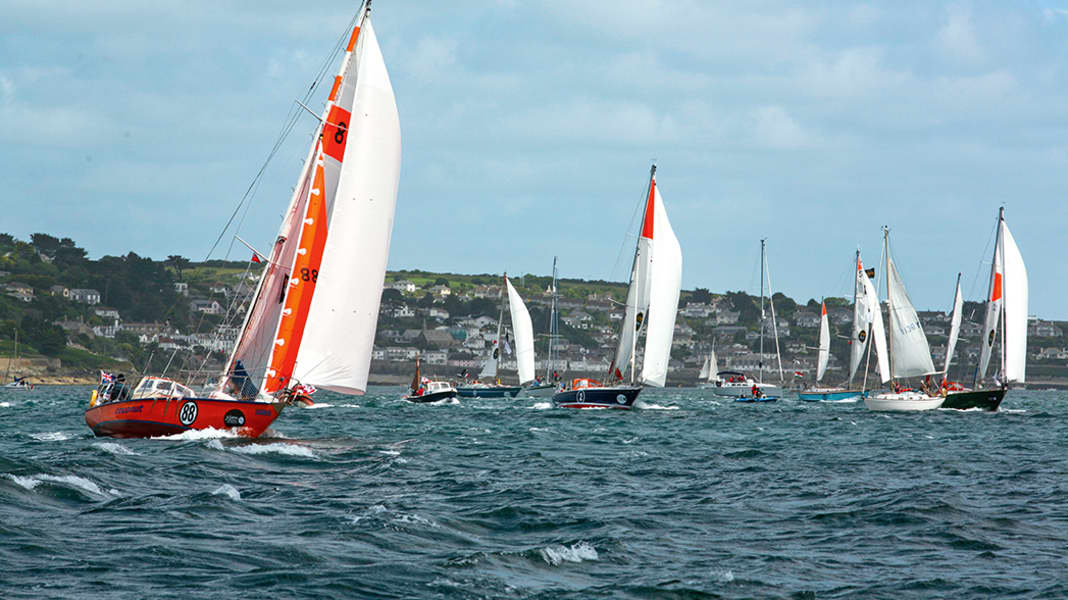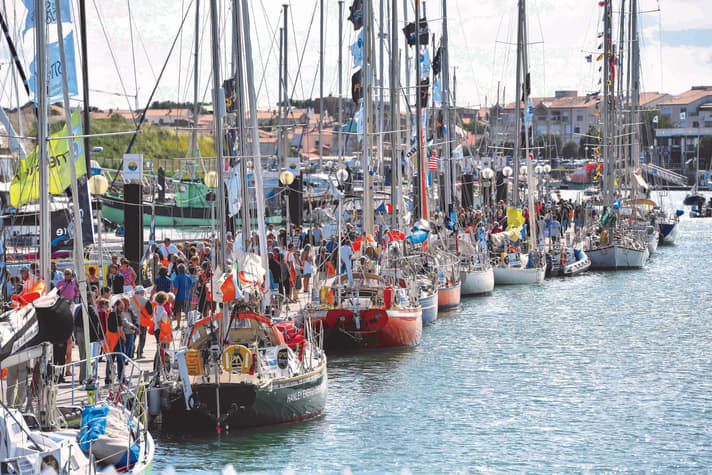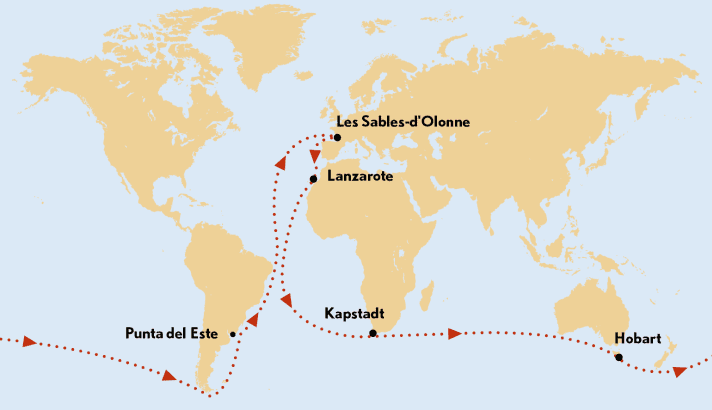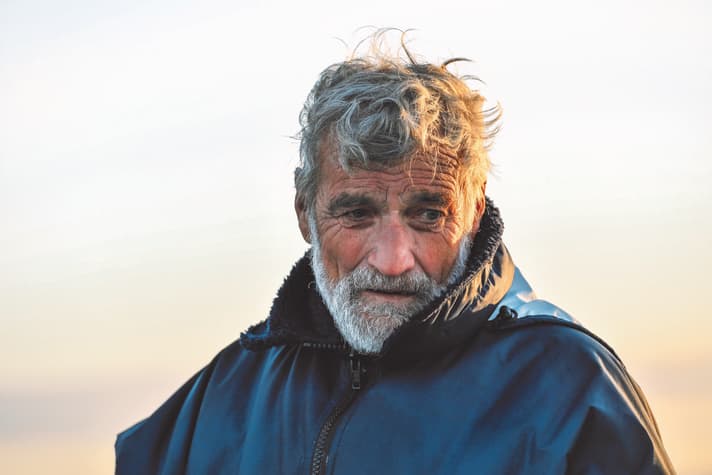Golden Globe Race: Start at the beginning of September, all race info here

One participant made headlines even before the start. The Indian Abhilash Tomy had a collision with a freighter in his Rustler 36 during the opening sail from Gijon to Les Sables. The bow of his boat was damaged. Tomy had already had a serious accident in the Indian Ocean with his previous boat during the 2018/19 Golden Globe Race and had to be rescued seriously injured. However, the local teams and shipyards in Les Sables promised their help so that the boat should be fit again by the start.

Around the world for the third time
This edition of the Golden Globe Race is the third, or more precisely the second of the modern era. In 1968/69, the first ever solo non-stop race around the world was sailed, the "Sunday Times Golden Globe Race". For the anniversary 50 years later, a solo non-stop regatta around the world was to take place again - at least that's what Don McIntyre had in mind. His event motto: "The Race returns - sailing like it's 1968". When the enterprising Australian circumnavigator and initiator of adventurous sailing events announced his idea, it met with a great response. Skippers from all over the world entered the Golden Globe Revival four years ago. In the end, 17 crossed the starting line off the harbour town of Les Sables-d'Olonne. The hurdles for qualification were already high back then.

Only five boats made it to the finish at all. The cancellation rate was therefore far higher than in the Vendée Globe. Many sailors abandoned the race due to loneliness or technical problems, some suffered mast breakage or even serious accidents, such as the Indian Abhilash Tomy or the British Susie Goodall.
It was a grey Tuesday morning when a lone masthead appeared over the horizon off the French Atlantic coast. There he was, the winner! On 29 January 2019, Jean-Luc Van Den Heede ( Interview at the end of the article ) returned from his non-stop circumnavigation and won the Golden Globe Race, which began almost exactly seven months earlier in Les Sables-d'Olonne. Despite all the criticism, the new edition of this historic sailing event was a success and is now entering its second round.
Many interested parties
The waiting list for starting places for this repeat was quickly full. Unlike the Vendée, the Golden Globe primarily attracts all those who want to take part in a regatta around the world once in their lives despite having a tight budget. However, a good third of the participants sail with sporting ambitions and want to win. The group of sailors in the Golden Globe Race, who come from all over the world, is correspondingly diverse. Some have already sailed around the globe, others still have limited ocean experience. The youngest, Elliott Smith from the USA, is 27 years old, while the oldest, Edward Walentynowicz from Canada, is 68.
The favourites for the Golden Globe Race






Some are trying their luck for the second time. Abhilash Tomy, Ertan Beskardes from Great Britain, Mark Sinclair from Australia and Tapio Lehtinen from Finland took part back in 2018. Others did not have their boats ready at the time and postponed their participation for four years. They are now starting with correspondingly extensive preparation time. Among them is the Austrian Michael Guggenberger.
Only older yachts are allowed
Many of the boats that were sailed in 2018 quickly found a new owner and are now taking part again - some of them further modified and equipped. The yachts that are sailed on are what make the Golden Globe Race so attractive anyway: Only series-produced cruising yachts with a long keel that were built before 1988 and are between 32 and 36 feet long are permitted.
After Jean-Luc Van Den Heede's success, his boat type, the Rustler 36, in particular, experienced a real run. As many as four of the 16 sailors who had qualified at the time of going to press are competing with this type of boat. Among them is co-favourite Damien Guillou, ex-preparateur of Vendée skipper Kevin Escoffier.
The organiser also wants to reflect the spirit of the times of the former Golden Globe Race with the specifications for the boats. The permitted equipment on board and the rules are intended to be reminiscent of 1968 and manifest the character of a retro regatta.
No electronic aids to navigation may be used. As in the past, navigation is carried out using paper charts and a sextant, a towed log and a compass. Communication is also rudimentary compared to today's offshore regattas: it takes place solely via radio. An EPIRB and satellite phone are only on board for emergencies and to communicate with the organiser.
More marketing planned
The marketing of the race has also influenced the choice of route. There are four so-called film drops along the 30,000 nautical miles around the globe. The skippers have to call at these waypoints off Lanzarote, Cape Town, Hobart and Punta del Este. There they have to deliver photo and video material and give an interview. Then they sail on.
In 2018/19, there were only two of these stops. The expansion to four "also takes away tactical options for the skippers," admits Lutz Kohne. The 27-year-old German works as deputy race director for the organiser and covers the race around the clock. "In 2018, the skippers from Hobart to France had an incredible number of options," says Kohne, who is an ambitious single-handed sailor himself and is aiming to take part in 2026. "That will now be severely limited by the stop in Punta del Este in Uruguay."

Other extensive changes to the racing rules mainly concern communication on board, which caused trouble four years ago. The suspicion arose that some skippers were using amateur radio to transmit weather information that friends or family back home could call up and interpret using weather tools - which came close to weather routing and is prohibited under the rules.
In order to prevent such external support this time, HAM amateur radios are no longer permitted on board. Instead, weather fax machines may now be used, with which the soloists can print out weather charts for their own interpretation on board.
Tough qualification
In addition, a further solo trip was included in the qualification requirements, which must be at least 2,000 nautical miles long, which may only be navigated with a sextant and which should take place on the boat with which the Golden Globe is sailed. The range of sailors becomes clear here: while some were able to cover almost half the distance of a circumnavigation on their boat in preparation, others struggled to make it to the starting line at all - or had to withdraw their entry just a few weeks before the start.
The biggest change is likely to be the timing. The start date has been moved back two months in the year, from the beginning of July to the beginning of September. "This should allow the southern latitudes to be reached later and reduce the risk of getting caught in storms," explains Deputy Race Director Kohne.
The fact that the aged cruising yachts are fundamentally unsuitable for the conditions in the harsh southern latitudes is a point of criticism that was already voiced many times at the first Golden Globe Revival. However, winner Jean-Luc Van Den Heede sees things differently. "The boats can do it. I would do it again."
After all, the ocean veteran will be out on the water in a support boat on Sunday, 4 September, when the starting signal is given - when the yachts disappear into the horizon where he reappeared on that Tuesday morning in January.

Interview with last year's winner Jean-Luc Van Den Heede
Mr Van Den Heede, many Golden Globe participants ask you for advice. What do they ask you most often?
Lots of things! It's about the weather, the sails and, and, and. I've just been asked how I stowed my wine. (laughs)
So, how did you do?
I had three-litre canisters with me, they are the most practical.
What else would you like to pass on?
That you need mental strength to make it and very good preparation. I was able to win because I was well prepared. I had three years to do it and I was a full-time sailor. That was the key to success.
What will be different this time?
In my opinion, the fact that there are four prescribed stops instead of two makes it more difficult. You're out there in your own world. The sudden contact takes you out of your own rhythm. When you suddenly meet people, it's strange and not easy.
Do you think the race has become more professional in the meantime?
The skippers still do it because they want to sail around the world and get there. Only around 30 per cent do it for sporting reasons. The challenge is to arrive! The big difference compared to 2018, however, is that you can now build on the experience of those who tried it four years ago.
You live in Les Sables and are directly involved in the preparations. Doesn't that make it incredibly appealing to be there once again?
Definitely. But I'm too old for that now, I'm not 35 anymore.
Who are you particularly rooting for, do you have a favourite?
Yes, of course, several of them. But anything can happen in this race. Anything can break! To win this race, you have to get there first.


